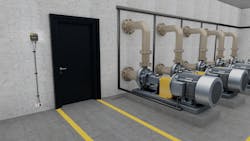How advances in wireless sensor technology are revolutionizing plant maintenance
Plant maintenance practices always evolve along with technology and organizational needs. Particularly in the wake of the COVID-19 pandemic, more organizations are assessing their needs and priorities — and how advances in technology can help. As some organizations have found, it is not always possible or practical to have people physically in a plant monitoring every asset. The ability to monitor assets remotely is helping maintenance and reliability teams revolutionize the way they keep plants up and running.
Wireless sensors, mounted on machinery, can monitor machines for specific attributes and use cloud-based software to send instant alarms to maintenance teams when a machine’s condition changes or falls outside of tailored thresholds. Wireless sensors are most commonly used to monitor temperature or vibration — and some sensors can do both. Wireless condition monitoring devices have existed for decades, but recent advancements have made them more affordable and accessible.
Using the technology and connectivity available today, maintenance teams can monitor machine health without needing to be physically in the plant. Wireless sensors reduce the number of trips maintenance team members need to make to assets that are in dangerous or hard-to-reach areas, allowing team members to focus their time and energy on the machines that need attention — and not the ones that do not.
Maintenance teams are now being asked to do more and more and often with smaller budgets. Automating some of the data collection process does not replace maintenance workers but instead allows them to optimize their efforts, leading to maximized asset life and measurable wins that help boost the bottom line.
Wireless sensors as part of a condition-based maintenance program
Condition-based maintenance is a practice that relies on machine condition, rather than a calendar, to identify and plan maintenance actions. Advances in wireless sensor technology have expanded the possibilities of condition-based maintenance, and affordable sensors have put this maintenance practice within reach for more organizations. Today, it is possible to use wireless sensors to monitor both a large number of assets and a wide range of asset types.
By monitoring machine vibration, maintenance teams can determine when a machine begins to have excessive or abnormal vibration patterns. All machines vibrate, but excessive or abnormal vibration can signal potential faults, as well as cause premature wear in components and eventually shorten asset life. Vibration monitoring enables teams to identify potential faults early on and take action before a machine has failed.
And by trending a machine’s vibration data over time, teams can gain insights into machine health and tailor their maintenance actions to maximize asset uptime and prevent unplanned downtime.
To monitor vibration, wireless sensors are placed directly on machines. Depending on how critical a particular machine is to a plant’s operations, maintenance teams can choose a sensor that monitors the machine continuously or one that monitors at regular intervals. The more critical a machine, the more important it is to detect any aberrations early on.
Battery advancements in wireless sensors
Performing measurements and sending the collected data to the cloud both require a wireless sensor to use energy. Battery life, and finding ways to maximize it, has been one of the main areas of focus for teams developing wireless sensors. Along with that, there has been a focus on reducing the amount of data transferred each time. Sending a lot of data uses more battery life, while sending a smaller amount of data uses less — meaning the battery will last longer. Finding the right balance is key. If the biggest drain on battery life is the transmission of data, how can that be minimized? A smart management of data transfer can help a battery last longer.
A wireless sensor can screen a machine and send a quick snapshot of data and then go back to sleep unless it detects something is wrong. This method simply tells teams whether a machine is good or bad. Another option is roughly equivalent to measuring a person’s pulse or blood pressure. From there, next steps can be determined if needed. This measurement for a short amount of time can indicate whether additional measurement — a more elaborate and intensive EKG, to continue the analogy — needs to be done. A short measurement can signal whether there is a need for more substantial and prolonged data collection.
Batteries in today’s sensors are typically longer lasting and smaller than the batteries in their predecessors. Innovation in batteries has led to batteries that are lighter, more powerful and even less expensive.
Energy harvesting: Moving beyond batteries
One current innovation is energy harvesting. In some cases, it is possible to forgo a battery entirely and rely on scavenging energy from the vibration, heat or light from a machine. Thermoelectric generator (TEG) harvesters and photovoltaic energy (PV) harvesters are just two types of energy harvesters available today.
TEG harvesters essentially suck up some of the heat that motors otherwise just throw away. A battery-less sensor can harvest energy from its surroundings to operate without the limitations of a battery that will run out. Instead of a battery, it has a little jumper wire that is like having its own gas pump — it gets fuel as it needs it, without the increase in size and weight that a battery would add. A battery-less wireless sensor is mounted on a machine and does its measurements as any other wireless sensor would.
Decreasing the size and weight of sensors by removing batteries also opens up the amount and types of assets that sensors can be used on. There are two main problems batteries cause as part of sensors: One is that the physical size at the footprint of the sensor on a machine can limit the number of locations where it can be placed. Batteries make sensors larger.
The other limitation is the frequency response of the sensor. Think of it like a diving board: If you have a long diving board and someone is on the end of it, when they jump, the diving board vibrates and bounces up and down. The bigger the sensor, the more it resonates — even to the point where the additional weight of a sensor can influence the resonance of the machine itself. Every structure has a resonance, and if we impact that resonance, that can cause a machine to be in a damaging condition. For certain sensitive machines, smaller sensors are ideal.
The details are in the data
Sensor size is one consideration. Another key to consider is the type of vibration data needed. The ability to get high-frequency spectral data is important, and a screening sensor that is linked to an energy harvester can only scavenge so much energy. Though it can do an FFT (Fast Fourier Transform) occasionally, it might not be able to harvest enough energy to do the more intensive, detailed types of data gathering. There comes a point where the data determines the size and energy needs of the sensor. A sensor that harvests energy may work well for screening and have enough energy to do the overall vibration snapshot, which is quick and does not take much energy, but may not be the right choice when detailed data is needed.
Bigger sensors can take full spectral data several times a day. There is a certain amount of power needed to be able to get an FFT spectrum. Some sensors can take screening data, but others can take analysis data, which is much more extensive. Screening data can detect whether a problem exists, while analysis looks at patterns to identify faults. The type of data required for each asset is based on how critical an asset is to an organization. No matter which type of vibration data is collected, vibration monitoring can be paired with other tools — such as oil analysis, thermography or power monitoring — as part of a complete maintenance program.
Vibration analysis is simply using a machine’s vibration data to identify faults. Detection involves trending a machine’s vibration level and quantifying any deviations from the norm. Analysis takes it a step further and, when a significant change is detected, involves determining the nature of the problem and what caused the change. Part of vibration analysis is recognizing patterns, but it takes extensive training and experience to be able to spot and read all the necessary patterns.
Once your team has the data, you need to be able to make sense of it and act on it for it to advance your maintenance program. Analysis software can take the data wireless sensors have collected and generate insights, notify people who can generate work orders and more.
Once teams know which fault is causing a machine to experience abnormal or excessive vibration, they can determine what steps they need to fix it — and when. This way, teams can extend peak asset performance and make the most of all of their resources, from scheduling to inventory to spending.
Wireless sensors are straightforward to set up and offer accurate and reliable data while requiring minimal maintenance and upkeep themselves. They help teams increase their efficiency, reduce their maintenance spending and increase asset life and uptime. Generating results and boosting ROI helps maintenance teams demonstrate their impact to the leadership of their organization.
Maintenance, like many other professions, has had some eye-opening lessons from the COVID-19 pandemic. The plant of the future means machines can tell us what is wrong with them — and maintenance teams can work smarter, not harder, as a result.
As a mechanical application and product specialist with Fluke Reliability, John Bernet works with customers from all industries to successfully implement their reliability programs. He has more than 30 years of experience in the maintenance and operation of commercial machinery and as a nuclear power plant electrician in the U.S. Navy. He holds a Category II Vibration Analyst certification and is a Certified Maintenance Reliability Professional (CMRP).
About the Author
John Bernet
Mechanical application and product specialist with Fluke Reliability
As a mechanical application and product specialist with Fluke Reliability, John Bernet works with customers from all industries to successfully implement their reliability programs. He has more than 30 years of experience in the maintenance and operation of commercial machinery and as a nuclear power plant electrician in the U.S. Navy. He holds a Category II Vibration Analyst certification and is a Certified Maintenance Reliability Professional (CMRP).


